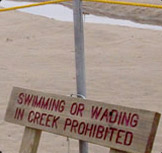Water: Habitat Protection
How EPA Protects Beaches - Habitat Protection

No swimming allowed.
We work in partnership with states, tribes, territories, local governments, sources of pollution, and the public to protect beaches.
In general, there are three basic ways to keep you safe from pollution at the beach:
- prevent pollution from getting on the sand and in the water,
- measure beach water to learn how clean it is, and
- tell people about beach conditions.
We provide grant funding to states, tribes, and local governments to do these. In addition, we have programs that indirectly protect beaches focused on watersheds, estuaries, wetlands, and coral reefs.
We are also carrying out our Clean Beaches Plan, which includes several steps to do an even better job protecting beaches.
Prevent pollution from getting on the sand and in the water
Pollution can arrive at a beach simply by people dropping trash. Storms are also a major problem; some sewer systems overflow directly into rivers, which eventually carry pollution and bacteria to beach waters. In addition, pollution can come from heavy concentrations of animals like pigs and chickens. We are working with states, tribes, territories, local governments, sources of pollution, and the public to reduce pollution from all of these.
Controlling harmful bacteria (also called microbes or pathogens)
Point source control (Direct)

Direct point source.
A "point source" is something that releases pollution directly from a well-defined place, like an industrial or sewage treatment plant. We work with states, tribes, and local governments to require point sources to obtain a permit before releasing wastewater. The following direct discharges contribute to high pathogen/bacteria levels:
Nonpoint source control (Indirect)

Indirect sources.
"Nonpoint source" means pollution that is swept into water bodies by water moving over or through the ground, like pesticide on a lawn. We work with states, tribes, territories, local governments, sources of pollution, and the public to control these indirect sources of pollution through:
Laws
- Clean Water Act
- Beaches Environmental Assessment and Coastal Health Act of 2000 (an amendment to the Clean Water Act)
- Coastal Zone Management Act
Enforcement
EPA, states, and local governments investigate and bring into compliance facilities who release more pollution than their permit allows.
Controlling trash and floating debris
Marine debris (solid man-made material like trash in our waterways) is a problem along shorelines. It is dangerous for people and animals and can cause problems for coastal communities and the fishing industry. Eighty percent comes from beachgoers, stormwater runoff, landfills, and floating structures. The rest is from ocean sources like trash from ships and offshore oil and gas wells. Learn more by exploring the following links:
Measure beach water to learn how clean it is
We provide grant money to states, tribes, and local governments to protect beachgoers from contaminated water at coastal and Great Lakes beaches. We're also developing tools to better measure, identify, and address microbes in recreational waters and to better understand how these pollutants affect people’s health.
- Create national standards and criteria (indicators) for pathogens (bacteria/ microbes) and work with states and tribes on adopting protections for their waterbodies.
- Create EPA-approved test methods
- Give grants to fund state monitoring programs
- Compile a list of beaches
- Conduct an annual survey of beach monitoring and closures
- Use research and development to obtain better environmental indicators and methods of detection
- Epidemiological study - how water quality affects people's health
- Development of new beach water quality indicators
- The EMPACT Beaches Project: Results from a Study on Microbiological Monitoring in Recreational Waters (PDF) (83 pp, 954K, About PDF)
- Predict beach conditions through modelling (PDF) (42 pp, 280K, About PDF)
- Appendices (PDF) (27 pp, 404K, About PDF)
- Water Quality Models
Tell people about beach conditions
In addition to helping measure pollution in water near beaches, EPA helps states, tribes, territories, and local governments inform people about their monitoring results through grants and the sites described below.
